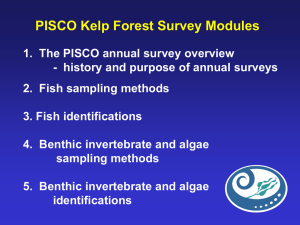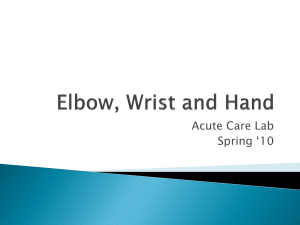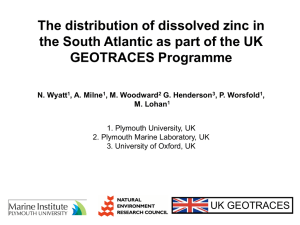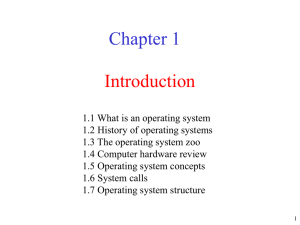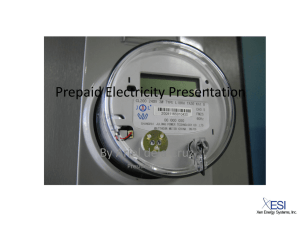PISCO benthic methods lecture
advertisement
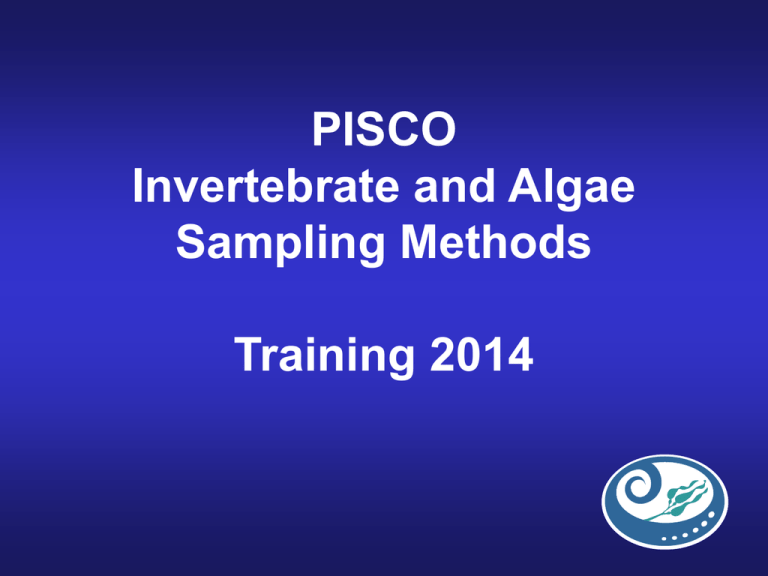
PISCO Invertebrate and Algae Sampling Methods Training 2014 2014 PISCO Training Overview for Invertebrates and Algae: • 2014 PISCO Kelp Forest Survey Modules • PISCO Annual Survey Design • Swath Protocol • UPC Protocol PISCO Kelp Forest Survey Modules 1. The PISCO annual survey overview - history and purpose of annual surveys 2. Fish sampling methods 3. Fish identifications 4. Benthic invertebrate and algae sampling methods 5. Benthic invertebrate and algae identifications Annual Survey Design When 2014: July through September Where 1. Different oceanographic regimes a) Lower upwelling – Southern Monterey Bay b) Higher upwelling – Point Lobos, Carmel Bay 2. Marine protected areas and “paired” comparison sites a) Lover’s Point SMR, Ed Ricketts SMCA, Pacific Grove Marine Gardens SMCA b) Point Lobos SMR, Pescadero Point, Soberanes Example schematic diagram of stratified random permanent sampling design. Pacific Grove Marine Gardens SMCA Fish transects at 5, 10, 15 and 20m Benthic transects at 5, 12.5 and 20m Asilomar SMR Existing PISCO long term monitoring unit New randomly selected monitoring unit ’89 ’99 ’02 Composite Kelp 2005 Kelp 100m buffer from reserve boundary Schematic diagram of depth-stratified sampling design Fish transects at 5, 10, 15 and 20 m Benthic transects at 5, 12.5 and 20 m Annual Surveys – Benthic Sampling Design Site 1 Area Zone (5 m, 12.5 m, 20 m) Transects: 2 …… 1999 Time 2 3 …… 25 1 2 S M D 20?? Annual Surveys: Spatial Sampling Design 1. Spatial (depth) stratification: Shallow (S) = 5 m, Mid (M) = 12.5 m, Deep (D) = 20 m designed to assure that all depth zones are representatively sampled for description of invert and algae assemblages. 2. Also to assure representative sampling from outer to inner edges of the reef! 3. If reef depths are constrained (e.g., 5-10 m), then sampling is distributed from outer to inner edges of reef including comparable depths (when possible) to those above (e.g., 5 and 10 m), plus additional depth strata to assure coverage from inner to outer edges of the reef. 4. Narrow reefs (inner to outer or across depth strata) are sampled with increased within-stratum replication (i.e. more than 3 transects per stratum per area (to approximate the usual 24 transects per site). Swath Surveys Swaths should extend one meter on either side of the transect line. 1 meter Top view of transect 1 meter Transect line Maintain reasonable speed (~20 minutes per transect) and only count invertebrates 2.5 cm or larger in diameter. Swath Surveys Swaths extend one meter on either side of the transect line as if draped over the substrate—remember, you want to cover 60 square meters of surface area Imagined 1 m extension on both sides of the transect tape Transect line End-on view of transect SUB-SAMPLING in each 10 m segment Once 30 individuals of a species are counted, indicate how many meters you have sampled within that 10 m segment (NOT THE METER MARK!) and discontinue counting until you reach the next 10 m segment. For example, if you count 34 Styela from the 20 m mark to the 17.5 m mark, then you note 34 @ 2.5 m. Be sure to count all individuals in the rectangle you sample, even if it is slightly over 30, since the goal is an estimate of density within a rectangular area. Use a flashlight at all times when surveying for swath invertebrates to make sure organisms in cracks and crevices are accounted for Algae are also counted using Swath techniques. Count all individuals 30 cm or larger, except Macrocystis and Nereocystis (>1 m) and Cystoseira (>6 cm diameter). 1m Efird UPC Surveys Uniform Point Contact Data are collected every 1 m along the 30 m transect tape Top view of transect Transect line 1 meter Transect tapes are marked at 1 m increments UPC Surveys Uniform Point Contact Remember not to bias your data! Use an imaginary long, sharp, steel rod (or lightning bolt) to place your point. Transect line Colonial tunicate on a solitary tunicate Lonhart/MBNMS If your point falls on a mobile invertebrate or epibiont, ignore it and make sure you are recording the organism underneath it that is directly attached to the substrate! Each 10 m segment contains 10 data points for each of three categories (substrate, relief, point): Substrate Relief Superlayer (special category) Point Substrate type Barlotti Superlayer – The special category The SUPERLAYER category counts things that have an impact on cover, but are not counted on the data sheet. Examples are drift algae and juvenile laminariales. After marking the presence of the superlayer, move the algae and record the primary substrate holder. Figurski Figurski You do not need 30 points in this category! Relief is the absolute difference in elevation between the highest and lowest point within a 1 m by 0.5 m rectangle 1 meter Top view of transect Transect line 0.5 meter Relief is determined within non-overlapping rectangles (1 m by 0.5 m) as depicted below 0 1 meter Top view of transect Transect line 1 2 0.5 m The rectangle is centered on the UPC point. Each rectangle extends 0.5 m on both sides of the tape, and 0.25 m in front of and behind the point along the tape. The rectangle for relief does NOT conform to the surface. Imagine it is a rectangular column along the plane of the tape and extending infinitely into the earth and up to the sky. Top view of transect Transect line 0 1 2 Within this rectangle you must look for the highest and lowest points, then determine the vertical distance between the two. Relief is binned into four categories: 0-0.1 m, 0.1-1 m, 1-2 m, and >2 m. The red line shown below is the imaginary rectangle (0.5 m along the tape in total, 1 m perpendicular to the tape in total) that is level relative to the earth’s surface and extends into rock and out into water as necessary. Transect line End-on view of transects Benthic Transect Strategy For Benthic surveys, the UPC diver and Swath diver work along a single transect tape. Benthic Transect Strategy The The UPCSwath diver swims the transect thethe entire 30 tape. meters diver begins taking tape data out along meter along the depth contour, without taking data. Benthic Transect Strategy The UPC diver secures the meter tape at the end and begins taking data in the reverse direction along the transect. Benthic Transect Strategy The Swath diver completes the 30 m invertebrate transect and begins to swim in the reverse direction taking algae swath data. Benthic Transect Strategy Once the UPC diver reaches the end of the 30 m transect, collect algae swath data while swimming back towards the Swath diver. These data can be added onto the UPC sheet in empty rows, but be sure to transcribe them onto the Swath divers data sheet immediately after the end of the dive. Benthic Transect Strategy Once they meet along the meter tape, one diver returns to the end and reels up the tape. Unlike fish divers, benthic divers begin the next transect by swimming in the opposite direction of the first transect. Safety Considerations 1. Dive profiles - approved by DSO - well within no-decompression limits - maximum depth 20 m - 3-5 min safety stops mandatory on dives >10 m 2. Air consumption - safety over data collection (500 psi @ surface) 3. Buddy system - members of a dive team are always in contact via the transect line 4. Sea conditions - diving will only be conducted in good conditions Dive Safety Brief 1. Dive log - sign out and in 2. Dive procedures - ascent rate 1 ft per 2 sec - deep-shallow - maintain dive team 3. On board communications: cell phone, VHF Ch 16 (Paragon), & SPOT system 4. First Aid & Oxygen - Shore and vessel 5. Evacuation plan: this is developed for each site and must be covered prior to the dive Locations of CHOMP and PG chamber Locations of LML, the SC harbor and Dominican Hospital
